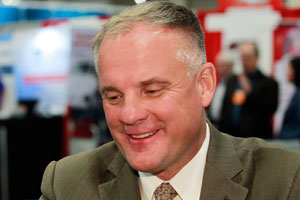Dana CEO James Kamsickas Advises Trump on Manufacturing

NASHVILLE, Tenn. — One of the people to whom President Trump listens on the economy’s manufacturing sector is Dana Inc. CEO James Kamsickas, who came here to talk to some of the people who buy his company’s truck axles and driveshafts.
Kamsickas was named to the White House Manufacturing Jobs Initiative by Trump on Jan. 27 and is one of the 28 members offering advice and perspective on taxation, international trade, infrastructure, regulations and the workplace of the future.
Dana is involved in international trade, doing business in 34 countries, with annual sales divided almost evenly between the United States and the rest of the world. However, the Maumee, Ohio-based manufacturer he has run since August 2015 is different from many other companies.
“Dana is a build-and-resell company. You have to build where you sell,” he said.
Dana does not build driveshafts in Asia or South America and export them to North America, for example. It sells in Asia or South America what it builds there.
Kamsickas said the taxation of trade is a mess that needs to be rearranged.
“This is more about fair trade than free trade, and how to put in a level playing field,” Kamsickas said Feb. 28 at the Transport Topics booth at the Technology & Maintenance Council annual meeting.
Two major tax problems, he said, are on the repatriation of profits earned abroad, and the discrepancy between import and export taxation.
The U.S. Department of Commerce reported that for 2016, the nation’s trade deficit for goods and services was $502.3 billion, up from $500.4 billion in 2015. Exports were $2.21 trillion in 2016, and imports were $2.71 trillion.
In addition to tax and trade matters, Kamsickas said he is especially interested in workforce issues. Just as TMC maintenance directors are perpetually searching for truck technicians, Kamsickas, 50, said Dana always is on the hunt for software engineers and skilled labor, and that working in manufacturing is not as glamorous a career as it once was.
“We need to improve vocational training, for mechanics, engineers and others,” he said, adding that it can be especially difficult luring skilled labor to rural areas.
After living in Europe for three years, Kamsickas said he is “a big fan” of the German, Austrian, Swiss method of education.
There, only about one-third of high school graduates move on to college. The rest receive a technical or trade education.
“If you don’t go to college, it’s not frowned upon,” he said.
“The goal should be for people to have pride in doing things with their hands. It’s a proud career.”
Kamsickas said the initiative members broke into four subcommittees, and they meet about once every three months.
A federal program he does like is the Energy Department’s SuperTruck work that offers seed money to manufacturers to develop more fuel-efficient trucks. Energy is on its second round of SuperTruck.
“I’m very bullish on SuperTruck. It’s cooperative across the commercial vehicle market.
“You won’t find that in other sectors where we’re involved. I think it’s a benchmark,” he said.

